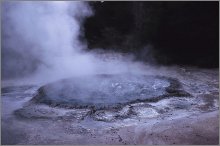How "Extremophiles" in Toxic Waste Sites
May Hold the Cure to Cancer
by www.SixWise.com
Organisms known as extremophiles -- which literally means
"someone who loves extremes" -- may one day provide
a cure for cancer and other diseases, and already help clean
up toxic oil spills. How? The organisms hold a variety of
secrets that allow them to survive in circumstances where
most other species would perish.
|

Some extremophiles can survive at temperatures significantly
above the boiling point.
|
Extremophiles Survive in the Harshest Environments
The first extremophile ever discovered was found in the late
1960s in the hot springs of Yellowstone National Park. The
organism thrived in temperatures above 160 degrees F and was
given the name Thermus aquaticus, or "warm bath water
dweller."
Since then, extremophiles have been found in even more severe
environments and conditions, and include:
-
Thermophiles and hyperthermophiles: Live in extremely
hot conditions, including significantly above the boiling
point.
-
Psychrophiles: Live in below-freezing cold temperatures.
-
Acidophiles: Live in highly acidic solutions.
-
Alkaliphiles: Live in base solutions.
-
Halophiles: Thrive in salty conditions.
-
Piezophiles: Survive in extreme high-pressure environments.
-
Xerophiles: Live in extremely dry conditions.
Other extremophiles are able to survive high doses of nuclear
radiation or thrive in jet fuel.
Potential Cancer Cures?
Extremophiles are very interesting to scientists because
they are able to adapt, thrive even, in the worst conditions.
The mechanisms by which they adapt may be able to be harnessed
into potential cures for cancer and many other diseases.
For instance, while halophiles protect themselves from high-saline
conditions by increasing their own concentration of salts,
and psychrophiles survive extreme cold using antifreeze-like
proteins, other extremophiles are able to easily repair DNA
damage -- even that from high-energy radiation.
Advantages such as these may be useful to one day help clean
up radioactive spills or provide protection against skin cancer,
migraines and leukemia.
Cancer Cures from a Toxic Waste Site
Among the most exciting of the extremophile discoveries are
the microbes from Berkeley Pit in Butte, Montana. Berkeley
Pit is a former open-pit copper mine, which contains 40 billion
gallons of highly toxic waste from its copper-producing past
and has earned the morbid honor of being the nation's largest
Superfund site.
Amidst the metal residue and toxic waste, scientists have
identified over 160 different fungi and bacteria.
"That's the coolest thing about this -- that toxic waste
could yield compounds that could help fight diseases,"
said Dr. Andrea Stierle, a research professor at Montana Tech
of the University of Montana.
"Some of the microbes in the pit may be every bit as
valuable as any ore that was taken from that same area,"
she said.
Part of the excitement stems from the microbes' ability to
kill off other organisms, which may be useful in killing cancer
cells.
"Like any organism growing with other organisms, they
compete for space," said Don Stierle, a chemistry professor
at Montana Tech (and Andrea's husband). "They've gotten
good in that competition for space, killing other organisms."
|

Aside from potentially holding a cure for cancer, extremophiles
may hold the secrets to life in outer space.
|
The husband-wife team has already identified microbes from
the pit that are effective against cancer cells in test tubes.
The National Cancer Institute is also interested in the microbes,
though they say much more investigation is needed before an
anti-cancer drug could be developed.
"We could potentially find compounds that could affect
any type of cancer," Andrea Stierle said. "Prostrate
cancer, lung, brain cancer ... It's still miles away from
a cure, but it raises the possibility, certainly the potential,
of helping with these horrible diseases."
A Sign of Life in Outer Space?
The existence of extremophiles here on earth has many experts
wondering if they also exist in the extreme conditions in
space. In fact, experts agree that if extraterrestrial life
does exist, it is likely in the form of extremophiles similar
to the ones on earth.
Among the many potential homes to space extremophiles are
Mars, which has hints of methane gas in its atmosphere that
may be a by-product of microbial life, and Jupiter's moon,
Europa, which is thought to have a subsurface ocean rich in
magnesium salts.
Also interesting is the discovery that microbes in Yellowstone's
hot springs use hydrogen as their primary fuel source, not
sulfur as was previously thought.
"Hydrogen is the most abundant element in the universe,"
said John Spear of the University of Colorado, lead author
of the study. "If there is life elsewhere, it could be
that hydrogen is its fuel."
Recommended Reading
Finding
Cures Under the Sea: The Search for New Medicines in Our Oceans
The
8 Most Unusual Sources of Potential Cancer Cures
Sources
Chicago
Tribune December 22, 2006
ABC
News October 10, 2006
LiveScience.com
SPACE.com